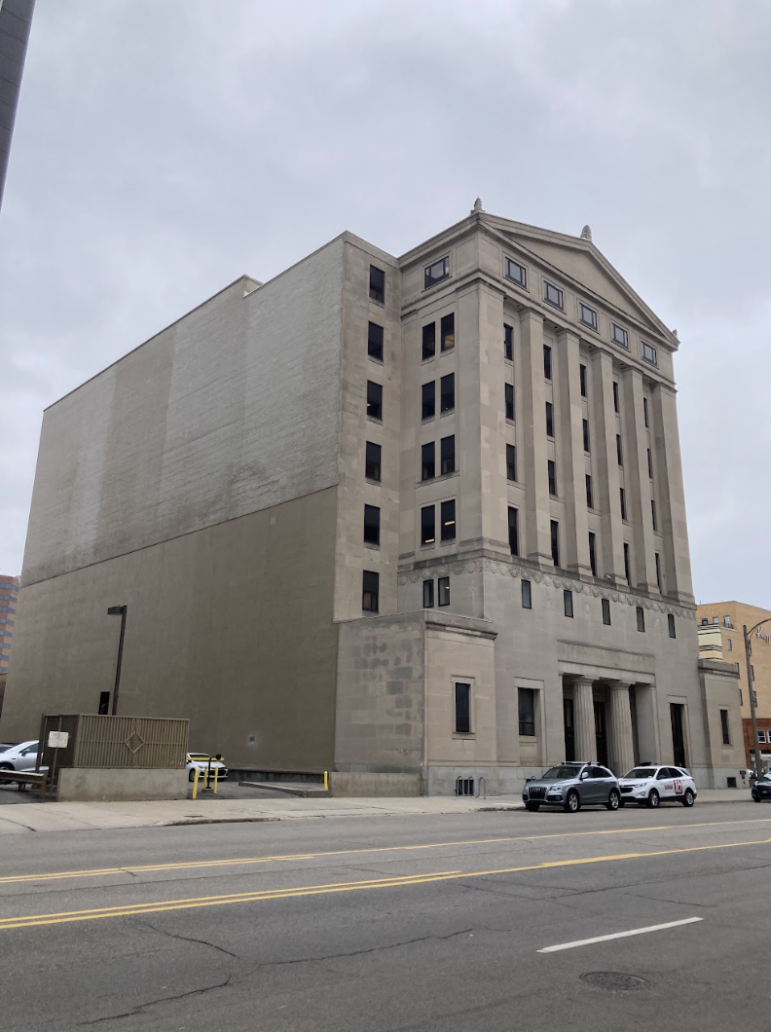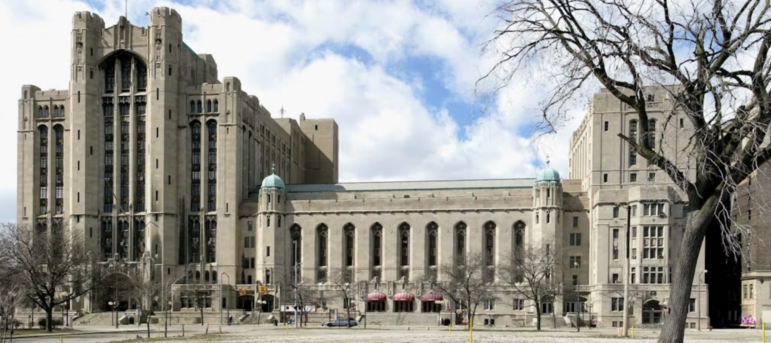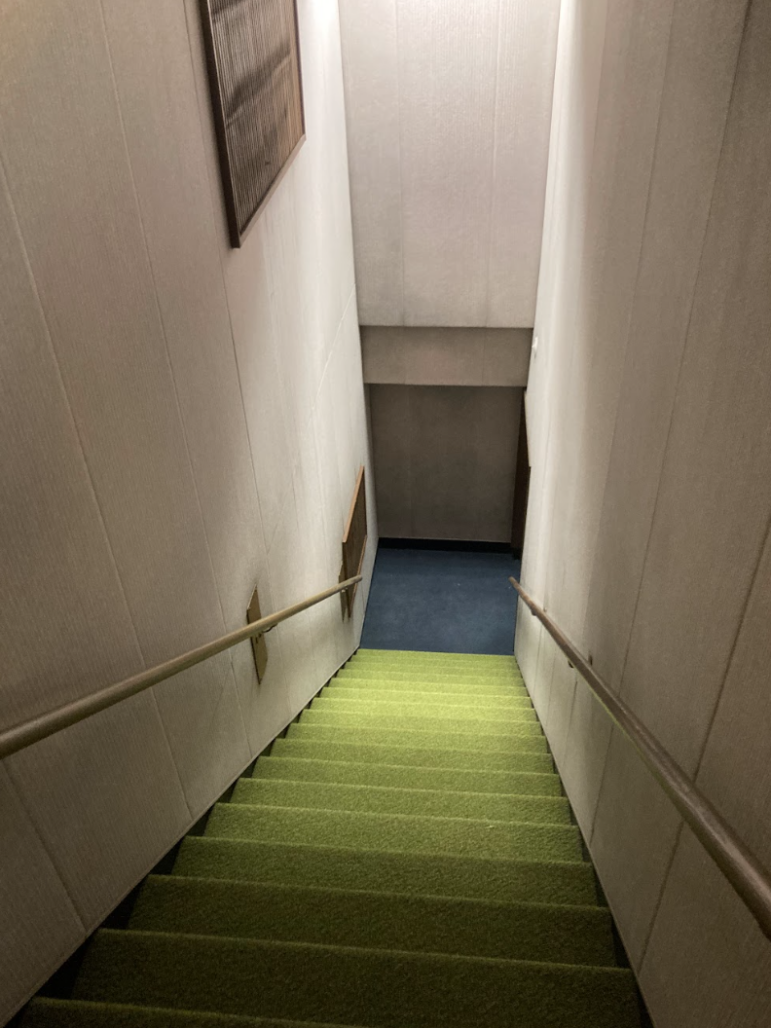
Theo Scheer
The vacant Masonic Temple in downtown Lansing is under consideration for renovation as a new city hall.By THEO SCHEER
Capital News Service
LANSING — Electricity still runs throughout the century-old building’s seven stories, illuminating the lime green carpets and elegant ballrooms as if they haven’t sat vacant for over a decade.
An eerie stillness permeates each floor. The illusion of a land frozen in time is broken only by the occasional missing ceiling panel and a yellow strand of construction tape.
The Boji Group, a Lansing-based real estate developer, opened up the Lansing Masonic Temple Building to the public recently to drum up support for plans to turn it into a new city hall.
The proposed make-over is far from unique.
Across Michigan, prominent, eye-catching buildings that were originally built for Freemason use have been repurposed after their original tenants moved out.
It’s a process that reflects the rise and fall of the once-influential organization and business owners’ desires to preserve local history.
Freemasonry, a fraternal organization that relies heavily on symbolism to guide its members’ conduct, had millions of members across the U.S. by 1930. Its temples and lodges, places for the groups to hold meetings and events, were found in many cities.
Colin Dickey, a cultural historian and professor at National University in San Diego, says that such lasting architecture is a remnant of a time when Freemasonry had a strong influence on American culture.
“Freemasonry is no longer seen as a hip cool thing for young men to do,” Dickey said. “It’s no longer seen as a way to get ahead in business or make social contacts with local bigwigs.”
“They struggle for enrollment and then, all of a sudden, they have these huge buildings and declining membership,” he said.
Repurposing those spaces is a testament to how buildings can outlast those who build them, Dickey said.
“Social groups are more fluid and ephemeral than stone and mortar,” he said.
The result is that Masonic temples can still be seen across Michigan, with many serving a new purpose.
Lansing
John Hindo, the president of the Boji Group, said that seeing other businesses repurpose Masonic Temples partially inspired the idea to sell Lansing’s to the city.
“If you look at old Masonic temples around the country that have been repurposed, there’s actually been a few that have been repurposed for municipal buildings,” Hindo said. “That’s kind of where the idea came up.”
Lansing’s first Masonic lodge was established in 1849. The growth of Freemasons’ popularity in the city inspired construction of the Masonic Temple in 1924, according to the National Register of Historic Places. It’s within blocks of the Capitol and the current city hall.
Cooley Law School bought the building in 1974 and greatly renovated its interior.
“In its heyday, there were a few thousand students in this building,” Hindo said. “Enrollment declined to the point where they didn’t need this building at all.”
The law college left the building in 2014 and it’s been vacant ever since. Boji Group bought it in 2021.
“It’s just one of many potential uses,” Hindo said of the city hall proposal. “It makes a lot of sense for the city to own it, be able to locate in it and be able to preserve some of the history of this community.”
Big Rapids
A prominent Masonic Temple was built in downtown Big Rapids in the early 1920s to support a rising Freemason culture in the area, according to the Big Rapids Pioneer.
It was nestled in the center of the city’s downtown district.
In the 1980s, the Masons relocated to a smaller facility that they still occupy. Star Shooters, a college bar now frequented by Ferris State University students, bought it.
Today, it’s home to a bar, a marijuana dispensary and an events venue.
Traverse City
Locals still refer to Front + Union — a boutique hotel in downtown Traverse City — as the “Masonic Building,” according to the business’s website.
Built in 1890, it’s hosted a wide array of businesses, including a hardware store and a barbershop.
The current owners made a point to honor its history when converting it into the hotel.
“By committing to keeping the original structure but pulling out 100 years of drywall and remodeling, we uncovered the beauty of the original brick walls, wooden planks, brick fireplaces and other hidden treasures,” according to Front + Union’s website. “By uncovering, cleaning up and reusing parts of the original construction, we can think of nothing more sustainable and, quite simply, cool.”
Detroit
Detroit is home to the world’s largest Masonic Temple.
Finished in 1926 after six years of construction, it clocks in at roughly 12 million cubic feet and 210 feet tall, according to the Detroit Historical Society. It was designed to accommodate over 40 masonic lodges.
It contains a large theater, several chapels, two ornate ballrooms, a library and a massive auditorium.
According to a local rumor, the architect, George D. Mason, committed suicide by jumping off the building. While tales of his haunting still circulate, in reality, Mason died peacefully in 1948.
Nowadays, the auditorium hosts weekly concerts. Its ballrooms, chapel, lounge, drill hall and other areas are available to rent. It’s still owned by the Masonic Temple Association of Detroit.

Visit Detroit
Detroit’s Masonic Temple on Temple Street is now a concert and events venue
Theo Scheer
Geen stairs inside Lansing’s vacant Masonic Temple.